|

Click on image for an
enlarged view
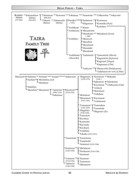
Click on image for
62 KB PDF
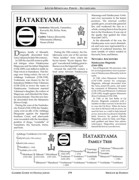
Click on image for
71 KB PDF
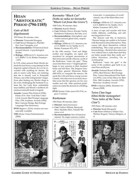
Click on image for
104 KB PDF
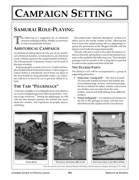
Click on image for
85 KB PDF
|
NEW!
Different
Worlds Presents
Gamers Guide to Feudal Japan
Shogun
& Daimyo
Military
Dictators of Samurai Japan
By Tadashi Ehara
The
samurai ruled the Land of the Rising Sun from the end of the 12th century
to the middle of the 19th century. At the top were the Shogun, the
military dictators who dominated Japan as regents to the Emperors. Below
the Shogun were the daimyo, provincial warlords who governed their
individual fiefs with virtual sovereignty.
Shogun
& Daimyo provides detailed information on the three dynasties of
Shogun and one Shogunal Regency that dominated Japan during the feudal
era, along with 171 daimyo clans that were defeated, dispossessed, or
otherwise dissolved before the end of the samurai era.
The
information is organized as an handbook for creating more realistic
backgrounds for role-playing games, boardgames, miniatures games, and
computer games. It is also useful for those writing historical novels,
screenplays, graphic novels, comic books, animé, and other creative
works.
Background
material includes history, government structure, and a kanji primer. For
gamers, a campaign setting is provided, along with notes on road travel,
gazetteers of the major routes, and the use of mon "family
crests." There is also a special section on samurai cinema with plot
synopsis and recommendations for 103 chanbara movies and TV shows.
Shogun
& Daimyo is a companion to Daimyo of 1876. The two books
together cover all the major clans and prominent families of feudal Japan.
Among
the Shogun and daimyo in this book you will find:
-
Taira
Kiyomori, the warrior-general who established the first
samurai-dominated government in the history of Japan
-
Minamoto
Yoritomo, Japan's 1st Shogun and eminent administrator, who moved his
military government to Kamakura, far from the meddling influences of
the Imperial Court in Kyoto
-
Ashikaga
Takauji, the controversial samurai general who fought for the
restoration of Imperial rule, but left the Court divided, and took
control with a new warrior government as the 1st Shogun of the 2nd
Shogunal dynasty of Japan
-
Takeda
Shingen, a military genius and innovator who fought, Uesugi Kenshin in
a series of legendary battles at Kawanaka-jima, and whose secret death
drove the plot of Akira Kurosawa's film Kagemusha
-
Toyotomi
Hideyoshi, a son of a peasant-warrior, who rose in power to complete
the unification of Japan that was started by Oda Nobunaga, but whose
ambitions led to the destruction of his clan
-
Tokugawa
Ieyasu, a minor daimyo who became Shogun, and established the 3rd and
last Shogunal dynasty that would rule the Land of the Rising Sun for
two-and-a-half centuries, until the end of the samurai era.
Profusely
illuminated with hundreds of woodcut prints, paintings, photos, family
trees, and crests.
Suggested for mature
readers.
Published September 2011
342 pages
DWP-4002
ISBN 978-0-9753999-5-8
$59.99
Click
here for reviews of Shogun & Daimyo
Click
here for a printable PDF of press release (1.7 MB)
Samurai Special!
Get both Shogun & Daimyo and Daimyo
of 1867 for $89.99, postpaid to U.S.A. customers.
DWP-Special-1
$89.99
|

Click on image for an
enlarged view
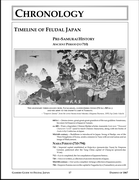
Click on image for
127 KB PDF
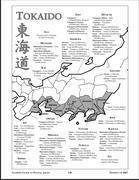
Click on image for
147 KB PDF
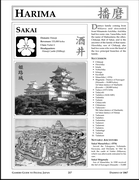
Click on image for
144 KB PDF
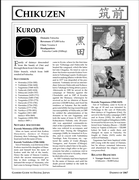
Click on image for
88 KB PDF
|
Different
Worlds Presents
Gamers Guide to Feudal Japan
Daimyo of 1867
Samurai Warlords of Shogun Japan
By Tadashi Ehara
Adventure
through a world more alien and more exotic than you have ever experienced before, yet
one that actually existed. Daimyo of 1867 provides a
comprehensive catalog of samurai warlords in feudal Japan. Included are
detailed information on every one of the 277 daimyo clans in the year
1867, towards the end of the samurai era.
Every daimyo is listed with
the image of the mon “family crest,” han “fief” name, revenue
size, rank at the Shogun’s castle in Edo, prior ancestry, and other
clan information. Many clan domain descriptions are embellished with
photos of their castles, history of notable ancestors, and information
about any branch families. Maps of castles and their surroundings are
provided wherever possible.
The information is
organized as an handbook for creating more realistic backgrounds for
role-playing games, boardgames, miniatures games, and computer games. It
is also useful for those writing historical novels, screenplays, graphic
novels, comic books, animé, and other creative works.
Background information
includes geography, history, major roads, social structure, religion,
monetary system, and government structure. A gamers guide is provided
with suggestions for scenarios, descriptions of martial arts training,
ronin, vengeance, the use of ninja, and the naming of a daimyo’s son
at a coming-of-age ceremony. There is also a special section with lists
of samurai-themed games.
Among the daimyo you will
find:
-
Asano Naganori, the
daimyo whose seppuku led to the revenge of the 47 ronin
-
Kudo Suketsuné, who
sparked the famous vendetta of the Soga Brothers, which took 18
years to complete
-
Ooka Tadasuké, a minor
judge with legendary wisdom, who eventually became daimyo
-
Yagyu Munenori, the
Shogun’s sensei for swordsmanship, a hatamoto who became daimyo
-
Oda Nobunaga, a minor
daimyo who began the final unification of Japan after a century of
civil war, and who is the inspiration for the video game series Nobunaga’s
Ambition
-
Tokugawa Ieyasu, a
minor daimyo who became Shogun, and established a dynasty that would
rule the Land of the Rising Sun for two-and-a-half centuries, until
the end of the samurai era.
Profusely illuminated with
hundreds of photos and images of maps, woodcut prints, and paintings.
Suggested for mature
readers.
Published April 2010
346 pages
DWP-4001
ISBN 978-0-9753999-3-4
$59.99
Click
here for reviews of Daimyo of 1867
Click
here for a printable PDF of press release (1.8 MB)
NEW!
Daimyo of 1867 now available as a color PDF from DriveThruRPG.

Click
here to take a look!
|
 
|
